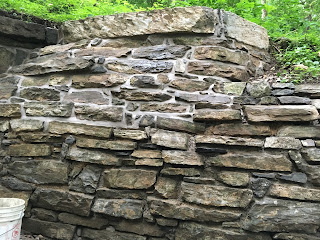This week I was back with the maintenance division, keeping that towpath clear, safe, and b-e-a-utiful. Once again, there was a small scheduling hiccup, and I spent the first day of the week with Officer Greene. Now normally I would not mind this anyway, as I certainly appreciate Ranger Greene's company as well as the chance to spend more time with law enforcement. But this time the delay worked out even better, as I got to experience another aspect of a law enforcement ranger's job I otherwise might not have been able to, going to court. Ranger Greene had a DUI case he needed to go to court for. Fortunately, I had never been to court before, so it was all new to me. But it was interesting to see it from behind the scenes. There was a lot more waiting around than anything else, and when it came time for Ranger Greene's case, the defendant simply entered a guilty plea, with the rest to be resolved at a later court date.
The next day I sat in on a permitting and compliance meeting. There were many projects and permits for park usage up for discussion. Some were relatively routine, such as large groups requesting to hold bicycling events in the park, or the approval for a cable company to update part of the park's internet access. Others were more interesting. One of the permits was from Red Bull, who wanted permission to use park property to film a professional kayaker as he went through Mather Gorge at the Great Falls Tavern section of the park. Another that was discussed had to do with one of the towns bordering the Canal needing to do maintenance on a water main. The main ran underneath town property, canal property, and property of the CSX railroad, which runs along much of the canal and was once the B&O Railroad that competed with the C&O while it was operational. The problem was that the actual boundaries of the properties are unclear and no one seems to have the records. Any excavation on park land requires an archeologist present in cooperation with ARPA, the Archaeological Resources Protection Act, and the town was being uncooperative.
 |
| Too Legit to Quit |
 |
| Caution: Proranger at work |
At the end of the day the crew leader took us up to this viewpoint at the top of a nearby mountain. You can't see the rest of the turn of the river in this picture, but this is one of the large horseshoe bends in the potomac river in a section called the paw paw bends. Across one of these winding sections of the river is where they built the Paw Paw tunnel that I shared in one of my other blogposts. In a few thousand years (I don't really know how long it will take) this meander in the river will connect, cutting itself off as the river once again flows in a straight line, leaving behind the stretch of river pictured as an oxbow lake. See that, I learned a few things in my geology course.
 |
| Dale mixes a batch of concrete mortar |
 |
| Culvert wing wall being repointed |
My last day with maintenance this week I spent running the towpath. This just means driving down a section of towpath in search of any trouble, mostly downed trees. There were no downed trees in our section, but there was quite a bit of garbage we hauled out.
I spent one of my days off this weekend checking out a pretty cool local attraction, Crystal Grottoes, a beautiful site to behold . This cave was discovered in the 1920's while quarrying for stone. It supposedly has more formations, or speleothems, per square foot than any other cave in the world, including stalagmites, stalactites, columns, ribbons, curtains, flowstones, soda straws, broccoli, popcorn, and cave bacon (a technical geological term). The cavern is only 8 miles away from my residence, so I rode my bike there. I got to cool off inside afterwards as the cavern is 54 degrees, year round. I was even dripped on by a stalactite growing on the cave ceiling, reported to be good luck by those who pedal tourist trips through caverns.






No comments:
Post a Comment